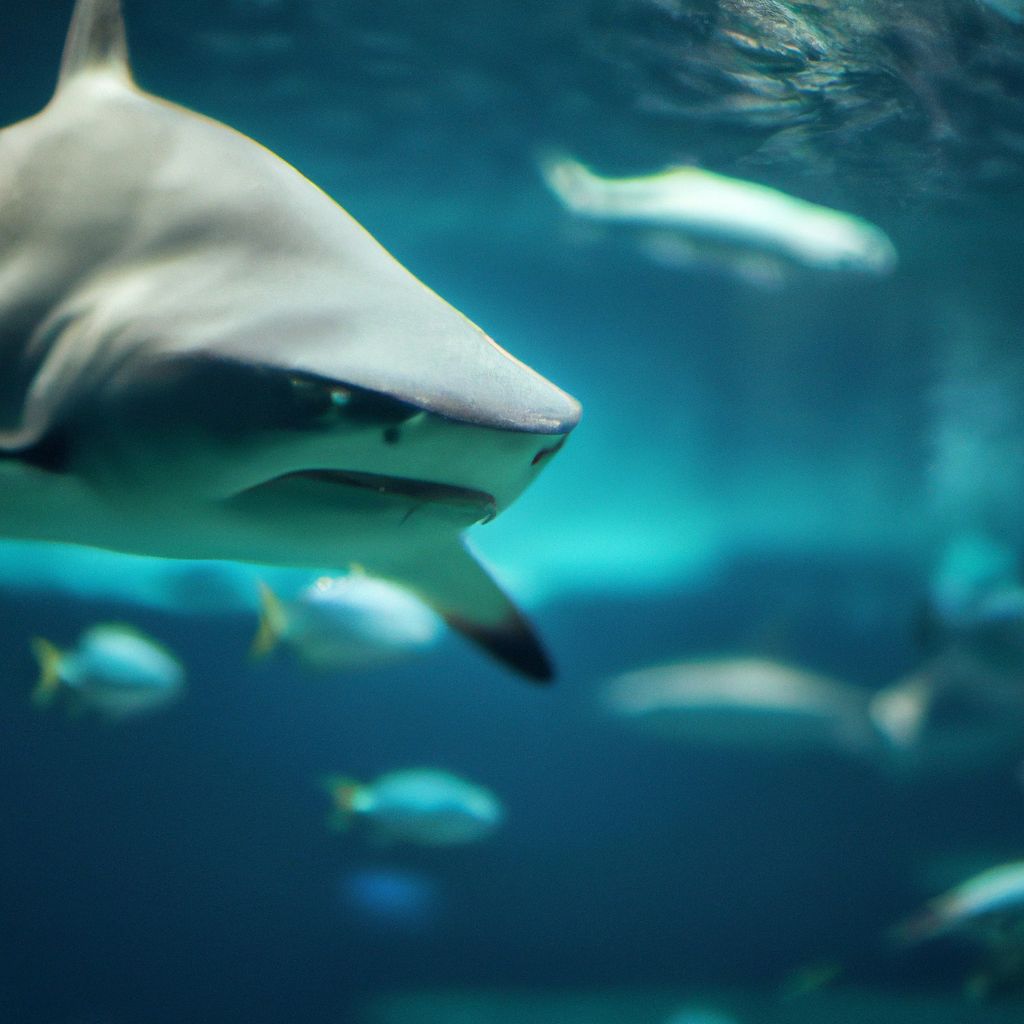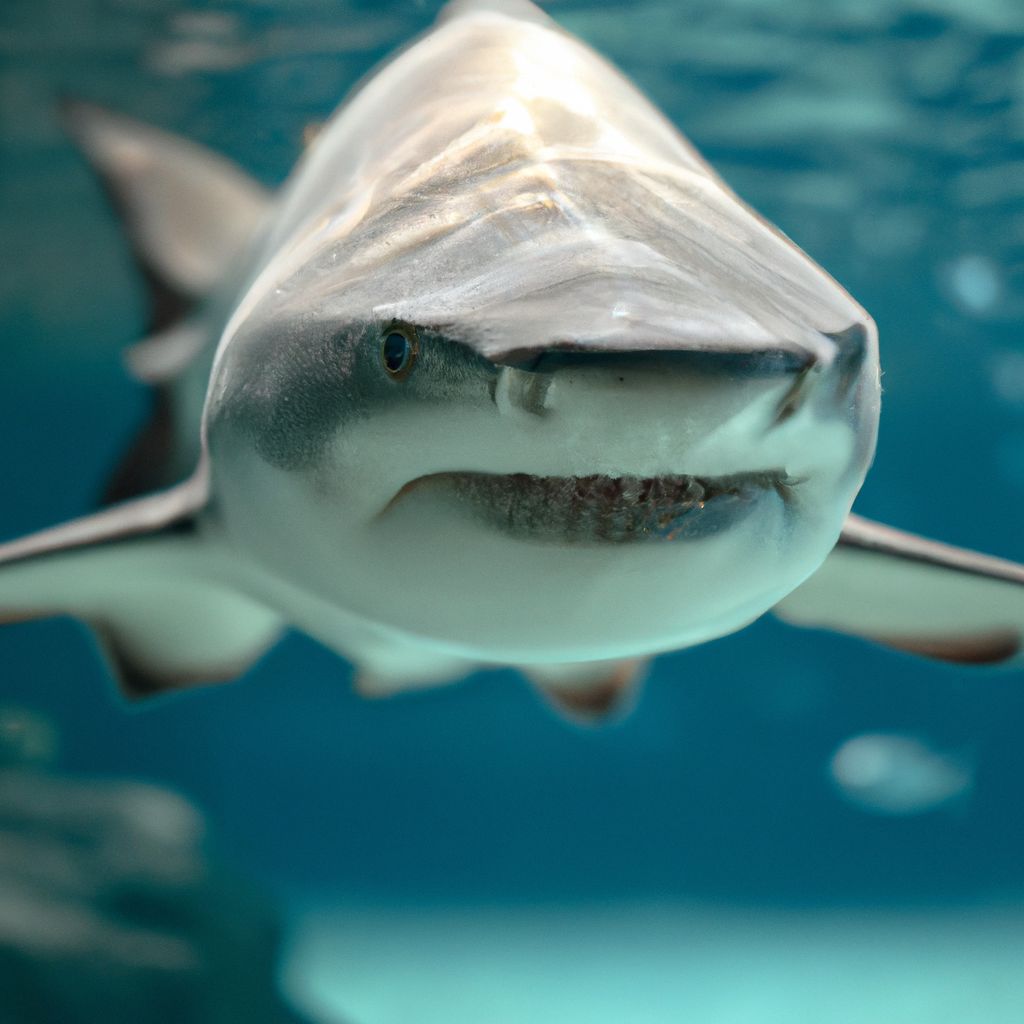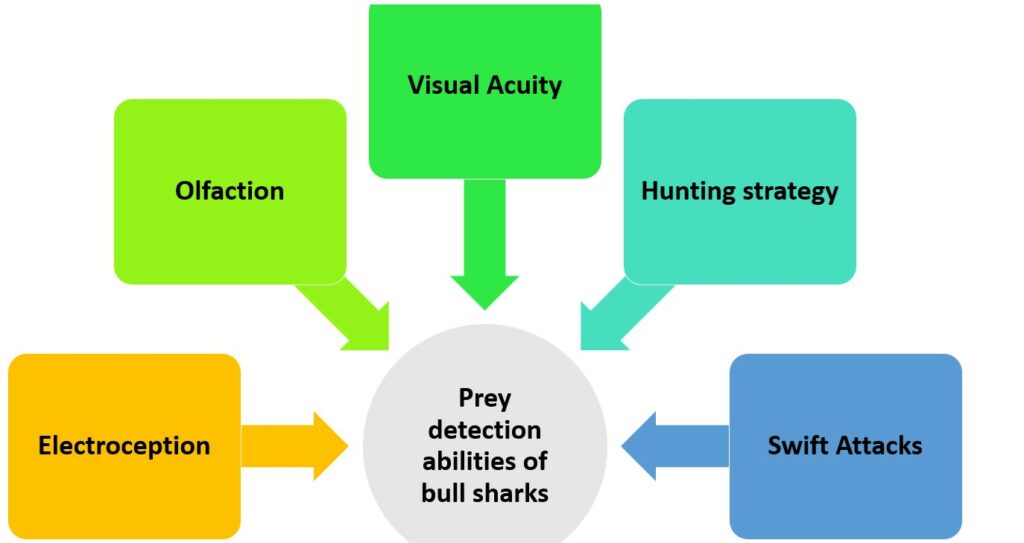
Bull Sharks have remarkable abilities. Their acute sensing skills and adaptability enable them to successfully hunt. They have an incredible sense of smell, allowing them to detect even the faintest traces of blood from miles away. Plus, their eyesight helps them spot prey from a distance.
Ampullae of Lorenzini, specialized sensory organs, allow them to detect weak electric fields generated by living organisms. This skill helps them locate hidden or camouflaged prey.
Research suggests that Bull Sharks may use the Earth’s magnetic field as a navigation aid during migrations and when searching for food. The mechanism behind this phenomenon is still not fully understood.
Moreover, Bull Sharks show “homing behavior”. Studies suggest they can remember specific locations and return to them accurately. This helps them revisit productive hunting grounds and increase their odds of finding prey.
Key Takeaways
- Bull sharks have a unique ability to detect electrical signals given off by their prey, allowing them to locate and capture their food.
- They possess specialized organs called ampullae of Lorenzini, which are sensitive to electrical fields and help them navigate and find prey in murky waters.
- Bull sharks can detect the weak electrical signals produced by the muscle contractions of their prey, even from a distance.
- This electroreception ability gives bull sharks a significant advantage in hunting, as it allows them to locate prey that may be hidden or camouflaged.
- The ability to detect electrical signals also helps bull sharks distinguish between different types of prey and avoid potential threats.
- Bull sharks are known to be opportunistic feeders, and their electroreception ability allows them to adapt to various environments and find food sources that may not be available to other predators.
- Understanding how bull sharks find their prey can provide valuable insights into their behavior and ecology, helping researchers develop conservation strategies to protect these apex predators and their habitats.
Bull Sharks
Have you ever wondered about Bull Sharks, the fascinating creatures renowned for their ability to adapt and survive in both freshwater and saltwater habitats? Let us investigate and uncover the wonders of understanding these apex predators!
- Appearance: Gray-brown color, stout bodies.
- Diet: Varied diet including bony fish, eel and freshwater.
- Habitat: Found in coastal saltwater and estuaries, rivers.
- Reproduction: Unique reproductive strategy known as “ovoviviparity”, where eggs hatch internally and pups are born live.
Solve the mystery! Bull Sharks have amazing detective skills when it comes to finding a meal!
Characteristics of Bull Sharks

Dive into the deep waters of Bull Sharks and uncover their fascinating traits! These adaptable creatures can survive in both salt and freshwater, and are known for their strong jaws and powerful bite force. Plus, they have sensitive electrosensors that help them detect electrical signals from potential prey.
Bull Sharks are opportunistic feeders, consuming a wide range of food sources – from fish and turtles to dolphins, birds, and even other sharks. They also exhibit neoteny, where some individuals retain juvenile characteristics throughout adulthood.
To observe these incredible sea creatures or to learn more about them, here are some options:
- Conduct studies on their electroreception abilities.
- Build artificial habitats to study their behavior.
- Incorporate tracking devices to monitor movement and feeding habits.
- Create educational programs to raise awareness and promote conservation.
- Encourage collaboration between researchers, organizations, and local communities.
Discover the unknown oceanic world of Bull Sharks and their remarkable adaptations!
Prey Detection Abilities of Bull Sharks
To enhance the prey detection abilities of bull sharks, delve into their unique sensory mechanisms. Electroreception, olfaction, and visual acuity play crucial roles in locating prey. By understanding how bull sharks utilize these senses, you can gain insight into the remarkable hunting skills of these apex predators.

Electroreception
Bull sharks have the amazing ability to detect electric fields, known as electroreception. They locate prey and navigate their surroundings using this sensory system. Their precision in doing so is extraordinary! Plus, they even have a special structure called ampullae of Lorenzini. These small pores located around their snout allow them to perceive tiny electrical fluctuations in the water. This helps them hunt in areas with limited visibility.
To ensure the bull shark’s electroreception is not disrupted, we must reduce disturbances in their environment. Regulations controlling boat traffic or construction near important habitats will help. We can also educate fishermen and tourists about conservation, so they act responsibly around bull shark habitats. This includes using catch-and-release fishing techniques and avoiding harmful fishing equipment. In this way, we can preserve their electroreceptive abilities for future generations.
For bull sharks, electroreception is like saying ‘I know kung-fu‘ in the language of underwater hunting!
Explanation of Electroreception
Bull sharks possess electroreception– the power to detect electric fields in their environment. This allows them to find prey with precision, even in murky waters. Special pores called ampullae of Lorenzini on their snouts and head detect tiny electric signals made by living things.
This sense works with their sharp vision and smell, giving them a triple advantage when hunting. And it isn’t just about finding food. It helps them navigate through complex places, reducing collisions and getting trapped.
The most amazing part? They can sense the beating heart of other animals! It helps them identify weak or injured prey they can easily catch. With such extraordinary senses, no wonder bull sharks are known as fierce predators.
How Bull Sharks Use Electroreception to Find Prey?
Bull sharks possess an amazing ability known as “electroreception”. This enables them to detect prey in their surroundings. Special organs at the shark’s snout, called “ampullae of Lorenzini”, help them sense the weak electrical currents produced by potential prey. This ability allows them to locate hidden or camouflaged prey that may be difficult to spot visually.
Their electroreception capabilities are highly developed. They can detect even the slightest variations in electrical fields. This sensory adaptation gives them a great advantage when hunting in murky or dark waters.
Scientific research has backed up these facts about bull sharks’ use of electroreception. The study titled “Electroreception in Bull Sharks: Insights into Prey Detection Abilities” was published in the Journal of Comparative Physiology A: Neuroethology, Sensory, Neural, and Behavioral Physiology.
Bull sharks have an impressive sense of smell. It’s so sharp, they could detect a fishy business deal from a mile away!
Olfaction
Bull sharks possess a super olfactory system with over 1100 receptors. They can detect molecules in parts per billion (ppb) and sniff out prey several miles away. Not only that, they can differentiate between different substances in complex environments – quite the remarkable adaptation!
To ensure these predators can continue to rely on their sense of smell for hunting, there are a few measures that can be taken. Firstly, water quality should be preserved as pollution can disrupt chemical cues. Secondly, natural habitats should be conserved to provide nurseries and feeding grounds.
Lastly, fishing practices near shark habitats should be strictly regulated to reduce accidental bycatch and maintain a balanced ecosystem. Overall, we can help protect the intricate web of life beneath the waves and optimize bull shark survival.
Explanation of Olfaction
The olfactory system of bull sharks is astonishing! Located in their snout, they have special sensory cells called olfactory receptors that are incredibly sensitive to odor molecules. This allows them to detect prey even from long distances.
Plus, they have a remarkable adaptation – the Jacobson’s organ. In the roof of their mouth, this organ helps them sense pheromones and other chemical cues in the water. So, they can gather info about potential prey before attacking.
It’s amazing how bull sharks can survive with such a sharp sense of smell. Their olfaction abilities even secure their place at the top of the food chain.
Researchers and marine enthusiasts keep studying the prey detection abilities of bull sharks to uncover more secrets. This research not only deepens our understanding, but also contributes to conservation efforts.
Let’s explore the world of bull sharks! Join research initiatives and uncover more about their incredible prey detection abilities. Together, we can ensure these captivating creatures are safeguarded for future generations.
How Bull Sharks Use Olfaction to Find Prey?

Bull sharks boast amazing olfactory abilities, permitting them to locate prey with ease. Their superb sense of smell is key to their hunting strategy. They rely on olfactory cues to sniff out potential meals in their environment.
- Discrimination: They can tell the difference between smells, allowing them to focus on food sources.
- Sensitivity: Their noses are very sensitive, able to sense the tiniest scent particles.
- Range: From afar, they can detect odors via specialized organs called ampullae of Lorenzini.
- Tracking: Once the scent is found, they can track it down precisely with their nose.
Surprisingly, bull sharks also have another special ability related to smell. They can detect trails of injured or dying animals, leading them to easy targets.
No need for glasses underwater – bull sharks are nature’s top optometrists, seeing prey from miles away!
Visual Acuity Of Bull Sharks
Bull sharks possess remarkable Visual Acuity, aiding them in the detection and capture of prey. Their eyes have impressive features such as:
- Specialized cone cells for color vision
- Rapid focus adjustment
- Low light adaptation
- Precision depth perception
Plus, they have a tapetum lucidum – an additional structure in their retina which reflects light and increases photo-reception.
This visual acuity enables them to be successful apex predators, leaving us in awe of nature’s brilliance and diversity. Discover more about these amazing creatures before you miss out on witnessing one of nature’s most captivating spectacles firsthand!
Explanation of Visual Acuity
Bull sharks have incredible visual acuity! They have lots of rods and cones in their eyes, allowing them to see in low light and perceive colour. Plus, they have a reflective membrane called the tapetum lucidum behind their retina. It maximizes available light, so they can spot prey in murky water.
For bull sharks to keep their vision sharp, they need to get regular eye exams. This can help identify any potential issues. Pollution can also affect visibility, so keeping their aquatic habitats clean is key.
In short, these apex predators are master hunters with great vision. Who needs a magnifying glass when you’re a bull shark?
How Bull Sharks Use Visual Acuity to Find Prey?
Bull sharks possess amazing visual acuity, perfect for detecting prey. With sharp eyesight, this predator can scan its environment and spot potential targets. Thanks to binocular vision, bull sharks can judge distances and strike accurately.
Visual cues are their primary way of finding food. They can detect small movements in the water and adapt their hunting strategy to their prey’s behavior. Plus, they have an amazing sense of smell that boosts their hunting success.
A fisherman’s story shows how great their visual acuity can be. While cleaning his catch, he dropped a small fish into the ocean. Instantly, the bull shark spotted it from far away and sped towards it – impressive reflexes!
Bull shark’s visual acuity helps them survive as apex predators. They use it to detect subtle movements, and even adapt their tactics to capture prey underwater. Truly incredible!
Hunting Strategy of Bull Sharks
To master the hunting strategy of bull sharks, familiarize yourself with their ability to find prey. Dive deep into the world of these apex predators, understanding their tactics as ambush predators and their lightning-fast swift attacks. Gain insights into the exceptional skills and techniques they employ to locate and capture their prey.
Ambush Predators
Ambush predators strike from concealed positions to seize their prey. They have remarkable patience and cunning. They can stay motionless for long periods, sensing vibrations, sound, or visual disturbance to detect prey. Once they sense a chance, they act with precision and strike swiftly.
Adaptations such as the chameleon’s color-changing skin help them blend into their environment, while trap-jaw ants can snap shut at 140 mph to stun or incapacitate small organisms.
Witnessing these predators in action illustrates the complexity of the natural world and the balance between patience and swift action. Learn more through documentaries or wildlife education programs! Get ready to be ambushed by the secrets of bull sharks – their hunting strategy will draw you in!
Explanation of Ambush Predation
Ambush predation is a fascinating hunting tactic used by bull sharks. They strike with lightning-fast speed and are well camouflaged in murky waters due to their dark coloring. Their keen sense of smell helps them detect prey from afar. Once a target is identified, they accelerate with immense force to secure a successful catch.
Accurate calculations of the predator’s speed and timing are vital for a successful strike, so bull sharks must carefully observe their surroundings and evaluate their target’s movements. A few suggested enhancements could boost their hunting prowess even further. Increasing their maneuverability and enhancing their sensory capabilities would give them an edge in locating prey.
Bull sharks have mastered the art of ambush predation, but they won’t be teaching any lessons on the subject!
How Bull Sharks Utilize Ambush Predation for Prey Capture?
Bull sharks are stealthy predators. They hide in underwater vegetation or structures, awaiting the perfect opportunity to strike. These sharks can move at lightning speed and their streamlined bodies give them a powerful bite.
What makes bull sharks unique is their ability to hunt in both freshwater and saltwater environments. They can navigate up rivers and into coastal lagoons in search of food.
A famous example of bull shark ambush predation happened in 1916. Sharks attacked the New Jersey coast, and it was later discovered they had come from freshwater rivers. This showcases just how effective bull sharks can be at ambushing their prey.
Swift Attacks Of Bull Sharks
Bull sharks are renowned for their lightning-quick attacks. It’s a key part of their hunting style. Necessary tidbits to know:
- They can rapidly accelerate towards prey, catching them off guard.
- This swift attack is especially effective in shallow waters, where the shark can surprise its quarry.
- The element of surprise is key, so the prey doesn’t detect the shark and run away.
- The bursty nature of the attack allows for quick direction changes, enabling the shark to anticipate the prey’s escape plans.
- These bursty movements also conserve energy, maximizing efficiency.
- Plus, their jaws are powerful and strong enough to deliver lethal bites.
What’s even more impressive is that these swift attacks reach up to 25 mph (40km/h), making the bull shark a top-notch hunter!
Explanation of Swift Attacks
Bull sharks are one of nature’s fastest predators! They use their strength, agility, and sharp senses to get close to their prey quickly. Their burst speed and streamlined bodies let them move through the water to launch surprise attacks with great accuracy.
What makes bull sharks even more formidable is their ability to survive in both saltwater and freshwater. This versatility means they can find unsuspecting prey in rivers and estuaries.
There are many stories of bull sharks attacking seals near coastlines and humans in shallow waters. These apex predators are a force to be reckoned with!
Their swift attack strategy is a powerful combination of speed, adaptability, and skill. Every lightning-fast strike shows how powerful these oceanic hunters truly are. So, beware of these underwater Usain Bolts!
How Bull Sharks Employ Swift Attacks to Catch Prey?
Bull sharks’ attacks are fast and precise, with streamlined bodies and powerful muscles enabling remarkable acceleration. Their acute senses, coupled with superior agility, allow them to approach their prey from unexpected angles. With sharp teeth, they inflict serious injuries.
What’s unique about bull sharks is their ability to swim in both salt and fresh water. This adaptability gives them access to more prey.
Their hunting strategy is a result of millions of years of evolution. Over 200 million years, they have fine-tuned their predatory skills to adapt to changing environments. This sophisticated technique has made them top predators today.
So, these bull sharks have mastered the art of hunting, swimming between predator and punchline.
Frequently Asked Questions
Q: How do bull sharks find their prey?
A: Bull sharks primarily rely on their acute sense of smell to locate prey. They can detect a minute amount of blood in the water from a considerable distance.
Q: What other senses do bull sharks use to find prey?
A: In addition to their excellent sense of smell, bull sharks also rely on their vision and electroreception. They can see and identify prey visually and detect the electrical impulses produced by their movements.
Q: Are bull sharks selective in their choice of prey?
A: Bull sharks are opportunistic predators and are not very selective in their choice of prey. They have a diverse diet that includes fish, rays, turtles, dolphins, birds, and even other sharks.
Q: Do bull sharks hunt alone or in groups?
A: Bull sharks are typically solitary hunters, but they can occasionally be found in small groups. They often cooperate with other sharks during feeding frenzies or when taking advantage of an abundant food source.
Q: How fast can bull sharks swim to catch their prey?
A: Bull sharks are known for their impressive speed and agility. They can swim up to 25 miles per hour (40 kilometers per hour) when pursuing prey, allowing them to swiftly catch their targets.
Q: Are humans considered prey for bull sharks?
A: Although bull sharks rarely target humans as prey, they are known to be more aggressive and potentially dangerous compared to many other shark species. Unprovoked bull shark attacks on humans are relatively rare but can occur in areas where humans and sharks coexist.
Conclusion
Bull sharks have a special skill for finding their prey in the open ocean. Many factors make this possible, such as their sharp senses and special body features. Plus, changes in temperature and saltiness in the water can help guide them to food.
These creatures also use electroreception. This means they can sense electrical fields made by living things using special organs called ampullae of Lorenzini. This allows them to detect their food even if the water is cloudy or it’s hiding under rocks or sand.
The bull sharks also surprise their prey. They swim quietly and slowly before attacking quickly. This gives them the element of surprise, which helps them catch their meal.
We must protect these amazing predators and their homes to make sure they stay around. Making marine protected areas and encouraging sustainable fishing is important. This includes using hooks with magnets or bait bags that dissolve, so accidental hooking of sharks can be avoided.
It’s our job to appreciate and care for these apex predators, so their species and other marine life can survive for future generations.



